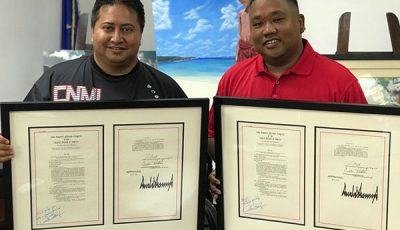‘Humanitarian parolees’ may now apply for resident status
Construction workers applications now open
Two of Delegate Gregorio Kilili C. Sablan’s signature laws are now being put into action, the U.S. Citizenship and Immigration Services announced yesterday.
The Disaster Recovery Workforce Act makes 3,000 additional CW permits available to repair damage caused by typhoons Mangkhut and Yutu and to prepare the Marianas for future natural disaster. The Northern Mariana Islands Long-Term Legal Residents Relief Act provides permanent status in the Marianas for certain groups of individuals, some 1,039 of whom have been living and working in the islands under humanitarian parole. Applications are now being accepted.
“The announcement from USCIS today is good news for the Marianas,” Sablan said. “I have been encouraging USCIS to make clear to employers that the 3,000 CW permits for construction workers became available as soon as my Disaster Recovery Workforce Act was signed into law on Dec. 20 last year. The application process is like any other CW permit.”
Implementation of Sablan’s Long-Term Legal Residents Relief Act, enacted on June 25 last year, was more complicated. Because the Marianas permanent resident status the law created is completely new, special forms and procedures had to be developed and approved. While that work was underway, USCIS extended parole for those affected by the law. In that way they could remain legally present, a requirement to qualify for the new permanent status.
A decade of work pays off
“Since my first days at work in Washington, [D.C.] I have tried to help those people who were overlooked, when federal immigration was extended to the Marianas,” Sablan explained. “People who were born in the Marianas and lived here all their lives had not been taken into account when the Consolidated Natural Resources Act put federal immigration in place. My Relief Act fixes that.
“People, who had permanent status under Commonwealth immigration law lost that status under federal immigration and were placed on temporary humanitarian parole. My Relief Act allows them to get permanent status again, but this time under federal law.”
The Relief Act also allows certain immediate relatives of U.S. citizens and in-home caregivers to gain permanent status in the Marianas. According to data provided to Sablan by USCIS in December 2018 when he was drafting his bill, 1,039 individuals could be eligible for the new Northern Marianas Permanent Resident status.
“Not only does the Relief Act take away the uncertainty that many families have been living with for over a decade,” said Sablan, “but by giving these one thousand individuals permanent status—and the ability to work in the Marianas—they no longer need CW permits. That means their employers are also saved the uncertainty—and the expense—of applying for CW work permits year-after-year.
“Especially now, with the economy struggling, anything we can do to reduce costs for business will help.
“I want to thank our colleagues at USCIS for making clear that the construction worker CW permits are available. Many Marianas employers had been unsure about this.
“I also want to thank USCIS for its work developing the forms and procedures needed to apply for Northern Marianas permanent resident status. It is not easy to create something new and get other the federal agencies to give it their stamp of approval.”
Complete information about the Disaster Recovery Workforce Act is available at https://www.uscis.gov/news/alerts/uscis-accepting-petitions-under-cnmi-disaster-recovery-workforce-act.
Details on the application process for the Long-term Residents Relief Act and who is eligible can be found at https://www.uscis.gov/news/alerts/uscis-opens-application-period-new-status-long-term-residents-cnmi. The application window is only open for 180 days.
Workforce Act regulations still needed
Sablan’s U.S. Workforce Act, enacted on July 24, 2018, still remains to be fully implemented. That law extended the Commonwealth-only Transitional Worker, or CW, permit program until fiscal 2030. For the first year, 2019, the number of permits was increased to 13,000. Then the number decreases to 5,000 in fiscal 2029, as more U.S. workers enter the labor force, trained with funds paid by employers.
The Workforce Act also puts tough restrictions on employers who fail to hire able and available U.S. workers, skirt U.S. labor law, or try to use foreign workers to undermine what U.S. workers are paid.
Sablan has been agitating the federal administration to issues regulations implementing the U.S. Workforce Act, Public Law 115-218, meeting with USCIS deputy director Mark Koumans earlier this year and urging action to clarify “touch-back” provisions in the law in a follow-up letter to Koumans this month. (PR)
























